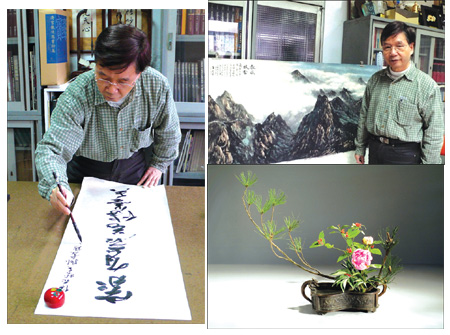Blossoming beyond the museum
Updated: 2010-03-13 07:51
(HK Edition)
|
|||||||||
|
Clockwise fron top: Huang Yung-chuan next to one of his Chinese ink-and-brush paintings in his study; a traditional Chinese floral arrangement Huang created; Huang demonstrates the art of Chinese calligraphy. central news agency |
A personal segue from overseeing the history and art of man to promoting the design and beauty of flowers is expressed in a mission to create a sprawling educational and inspirational 'flora center'
When Huang Yung-chuan retired as director of Taiwan's National Museum of History in January, it was more of a sideways move than any attempt to slow down from a lifetime of work in the field of art and culture.
Having staged a hugely successful Van Gogh exhibition in Taipei as his swan song at the museum, Huang has already turned his attention to another ambitious project.
"I want to build a flora arts cultural park in Taiwan," said the 66-year-old professor who is also the founder and chairman of the Chinese Flora Arts Foundation (CFAF) in a recent interview with CNA.
He said the Van Gogh exhibition, the first of its kind in Taiwan, was "the perfect end" to his 40-year career at the museum, which saw him rise from a low-echelon curator to the museum's top post. Now he wants to put his efforts into creating a world in which culture is adorned by flowers.
"With flowers as part of culture, the world will be beautiful," said Huang, who teaches traditional Chinese flower-arranging theory at CFAF.
He noted that human life is inextricably linked to plants, but lamented that most public parks do not reflect this concept.
"There is a lack of culture in the existing grassy public parks."
They display gardening skills - which according to Huang is "nothing but agriculture."
He went on to outline his vision of a more eclectic approach that would encompass aspects of Chinese culture such as flower displays, paintings, pottery, tea serving, music and poetry. In short, the park of his dreams would be a cultural museum revolving around the floral arts and their historic cultural importance, he said.
In ancient China, intellectuals used plants to bring nature into their living spaces, to honor their ancestors, gods and emperors, and in general to project a certain lifestyle, said Huang, who also teaches art at National Taiwan Normal University as a part-time professor.
He noted that during the Song Dynasty (960-1279) it was popular to "burn incense, drink tea, hang paintings and arrange flowers."
Learning to master those four skills and use them as art was part of the basic education of the day, according to Huang, a calligrapher and a master of traditional Chinese ink-and-brush painting.
"Intellectuals of that era believed that the art of flower arrangement was an embodiment of morality, which they thought was central to human dignity," said Huang, who is known for his efforts to revive the art of Chinese flower arranging through the exploration of ancient Chinese philosophy.
By the Ming Dynasty (1368-1644), a whole aesthetic theory related to flower arranging had been developed, and this influenced culture in Korea and Japan at the time, but regrettably was not passed down in China, because of ensuing wars, he explained.
Flower arranging used to be one of the basic subjects taught in Japan's middle schools, he went on to say, adding that Taiwan should promote the art form as an extra-curricular activity.
According to Huang, morality and sincerity will be the two main themes of the CFAF's 2010 Flora Art Exhibition that will be held at the National Museum of History April 9-18.
"Flowers can help people avoid bad influences in their lives," he said. "People who love flowers are usually lovely and outstanding."
His plans to develop a floral arts culture park have already hit one snag, however - finding a suitable site.
The available plots of land are either in remote areas or too small, he said.
However, he was firm in his determination to continue his efforts to build what would be the first park of its kind in the world.
It would require enough space for an open-air flower garden, a big parking lot and a building that could be used for exhibitions and cultural activities related to the floral arts and which would be able to accommodate at least 2,000 people, according to Huang.
Most importantly, it must be easily accessible, he said.
He envisions regular floral exhibitions at the park, which he said could also be a venue for activities that could gain greater cultural significance from being held there.
For example, he continued, go (known as weiqi in its birth place China, a very sophisticated board game between two players using strategic thinking to occupy as large an area on the board as they can) competitions could be held in the park, as this would give them more of a cultural character.
A number of civic groups and individuals have pledged financial support for the project, Huang went on to say, adding that once he obtains a suitable plot of land, construction of the park can begin.
Until then, he concluded, there are ample opportunities for people to see around them the cultural significance of flowers, as the theme is everywhere, from food, clothing and shelter, to transport and literature.
China Daily/CNA
(HK Edition 03/13/2010 page4)
